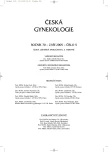Embolization of Uterine Arteries during Myoma Treatment from the Patient’s Point of View
Embolizace děložních tepen při léčbě myomů z pohledu pacientek
Cíl studie:
Získat informaci o zpětném pohledu pacientek na léčbu myomů pomocí embolizace uterinních arterií (UAE).
Typ studie:
Retrospektivní multicentrická klinická studie.
Název a sídlo monitorujícího pracoviště:
Gynekologicko-porodnická klinika 1. LF UK a VFN, Praha.
Metodika:
45 žen, které v letech 1999–2003 podstoupily UAE z indikace uterus myomatosus, bylo obesláno dotazníkem. Dotazník obsahoval celkem 26 otázek, týkajících se informovanosti pacientek a jejich očekávání od výkonu, průběhu embolizace, časných obtíží (postembolizační syndrom) a celkového hodnocení léčby v delším časovém odstupu. Část žen, které na dotazník odpověděly a byly ochotny spolupracovat, byla následně konzultována, vyšetřena a zařazena do sledování, popřípadě jim byla doporučena další léčba.
Výsledky:
Ze 45 pacientek ve věku od 26 do 48 let odpovědělo na dotazník 31 (68,9 %). UAE byla indikována 12krát (38,7 %) pro symptomy myomů, 10krát (32,3 %) pro sterilitu, 5krát (16,1 %) jako prevence růstu myomů před plánovanou graviditou a 4krát (12,9 %) pro asymptomatický, ale rostoucí myom. Celkem 27 žen (87,1 %) uvedlo, že jim byla nabídnuta i jiná alternativa léčby, kterou odmítly. Intenzita obtíží, způsobených výkonem, splnila očekávání u 18 (58 %) žen, 5krát byl výkon méně nepříjemný a 8krát horší než předpokládaly. Dlouhodobé výsledky hodnotí kladně 87,1 % pacientek, jen 12,9 % považuje léčbu za neúspěšnou. Z 11 žen plánujících graviditu 5 otěhotnělo, z toho 3 porodily v termínu porodu a 2 potratily v I. trimestru.
Závěry:
Hodnocená metoda je z hlediska pacientek vysoce úspěšná, dobře tolerovaná a zatížená nízkým rizikem komplikací. Zda ji lze rutinně nabízet i ženám, které plánují graviditu, nelze v současné době jednoznačně zodpovědět.
Klíčová slova:
embolizace děložních tepen, hodnocení výkonu pacientkami, myom, postembolizační syndrom
Authors:
Z. Fučíková 1; M. Mára 1; J. Mašková 2,3; D. Kužel 1; P. Fencl 3; J. Svárovský 1,4; P. Drbohlav 1; J. Mašata 1; J. Křivánek 3
Authors‘ workplace:
Gynekologicko-porodnická klinika 1. LF UK a VFN, Praha, přednosta prof. MUDr. A. Martan, DrSc.
1; Radiodiagnostická klinika 1. LF UK a VFN, Praha, přednosta doc. MUDr. J. Daneš, CSc.
2; Radiodiagnostické oddělení ÚVN, Praha, primář pplk. MUDr. F. Charvát
3; Gynekologické oddělení ÚVN, Praha, primářka MUDr. H. Kašpárková
4
Published in:
Ceska Gynekol 2005; 70(5): 383-388
Category:
Original Article
Overview
Objectives:
To acquire information about the patient’s follow-up evaluation of treating fibroids by uterine artery embolization (UAE).
Design:
A retrospective multicenter clinical trial.
Setting:
Department of Obstetrics and Gynaecology, 1st Faculty of Medicine and the General Faculty Hospital, Charles University, Prague.
Methods:
45 women who underwent the UAE due to uterine fibroids from 1999 to 2003 were asked to complete a questionnaire. The questionnaire included 26 questions asking how the women had been informed and what they had expected. Further questions were focused on the course of embolization itself, early post-procedural difficulties (post-embolization syndrome) and patient’s overall evaluation of treatment in a longer term. Those women who had completed the questionnaire and had been ready to co-operate were thereafter examined and included in the follow-up monitoring and, if necessary, further treatment was recommended.
Results:
Thirty one out of 45 patients from 26 to 48 years of age, who had been addressed (68.9%) answered the questionnaire. UAE was indicated 12 times (38.7%) on account of symptoms, 10 times (32.3%) because of sterility, 5 times (16.1%) as a preventive measure within the framework of family planning and 4 times (12.9%) for an asymptomatic but growing leiomyoma. Twenty seven (87.1%) women were also offered an alternative treatment, which they refused. As far as problems are concerned, 18 (58%) women described the course of treatment as corresponding with what they had expected, 5 times it was less painful, and 8 times it was worse than expected. The long-term results were considered as positive by 87.1% of responders, only 12.9% considered the treatment as failure. 5 in 11 women planning pregnancy became pregnant, 3 of them gave birth in term and 2 miscarried in the 1st trimester.
Conclusion:
From the point of view of the patients, the evaluated method proves highly successful, it is well tolerated and it involves a low risk of complications. It is not possible, at this point, however, to give an unequivocal answer to the question whether the method should also be routinely offered to women who are planning pregnancy.
Key words:
evaluation of the procedure by patients, leiomyoma, post-embolisation syndrome, uterine artery embolization
Labels
Paediatric gynaecology Gynaecology and obstetrics Reproduction medicineArticle was published in
Czech Gynaecology

2005 Issue 5
Most read in this issue
- The Perineal Body Length and Injury at Delivery
- Embolization of Uterine Arteries during Myoma Treatment from the Patient’s Point of View
- Antifungal Effect in Selected Natural Compounds and Probiotics and their Possible Use in Prophylaxis of Vulvovaginitis
- Does Oocyte Retrieval Influence the Following Morphological Quality of Embryos?
